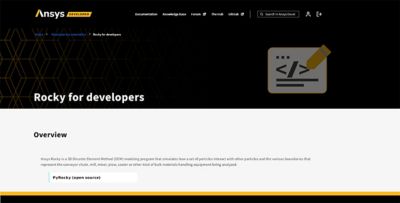-
United States -
United Kingdom -
India -
France -
Deutschland -
Italia -
日本 -
대한민국 -
中国 -
台灣
-
Ansys stellt Studierenden auf dem Weg zum Erfolg die Simulationssoftware kostenlos zur Verfügung.
-
Ansys stellt Studierenden auf dem Weg zum Erfolg die Simulationssoftware kostenlos zur Verfügung.
-
Ansys stellt Studierenden auf dem Weg zum Erfolg die Simulationssoftware kostenlos zur Verfügung.
-
Kontakt -
Karriere -
Studierende und Akademiker*innen -
Für die Vereinigten Staaten und Kanada
+1 844,462 6797
ANSYS BLOG
February 26, 2024
What’s New for Rocky in Ansys 2024 R1
In 2024 R1, Ansys Rocky continues to address customers' needs by delivering features that enable users to perform accurate discrete element method (DEM) simulations. This release keeps the focus on multiphysics, provides new smooth particle hydrodynamics (SPH) capabilities, and optimizes user experience, which creates limitless possibilities in particle dynamics simulation.
Take a look at some of the new functionalities.
Two-way Thermal Coupling Between Rocky and Mechanical
This release brings a significant leap in equipment thermal analysis with the implementation of two-way thermal coupling with Ansys Mechanical.
Users can now run thermal simulations in which particles and equipment affect each other in thermal solutions simultaneously, amplifying insights and boosting the depth of thermal analysis.
Coarse-grained Modeling Extension
The coarse-grained modeling capability was extended to cover the liquid bridge adhesion model and SPH-DEM coupling, unlocking the ability to speed up more complex particle simulations.
Improved Visual Analysis
Particle transparency functionality is very useful for visual analysis, mainly for simulations with a shell particle shape (like plastic bags, leaves, potato chips, pieces of fabric, etc.).
Elevating SPH Capabilities with Rocky
Discover fresh perspectives in fluid simulation by leveraging new state-of-the-art SPH capabilities for enhanced insights.
Incompressible SPH (iSPH):Through this beta module, you can use a new algorithm for computing pressure that speeds up simulation by four times compared to the default SPH formulation.
Heat transfer coefficient on walls: You can now calculate the heat transfer coefficient (HTC) on walls to conduct convective thermal analyses of equipment.
SPH point cloud air drag module: This beta feature accounts for the interaction with a static velocity vector field representing airflow in a one-way coupling scenario with Ansys Fluent when solving the liquid phase using Rocky’s SPH solver.
Non-Newtonian Models: The dynamics of fluids, like ketchup, require non-Newtonian viscosity representation to be properly modeled and simulated. Rocky has three new viscosity models, which allow users to capture the behavior of non-Newtonian fluids.

Two-way thermal coupling between SPH fluid flow inside tubes and a heat source applied to the geometry in Ansys Rocky and Ansys Mechanical, respectively (left). Both are being computed through system coupling, and heat transfer is then post-processed with Ansys EnSight (right).

With coarse-grained modeling simulation, you can estimate the coating distribution between particles. Liquid bridge adhesion plays an important role in the particles’ dynamics, which can now be sped up with an extension of the coarse-grained model in Rocky.

In a plastic bag transport simulation, the shell particles that represent the plastic bags can be set to be transparent, enabling analysis of the contents within.

Airflow resulting from the movement of gears significantly influences high-speed gearbox simulations. Its influence on fluid flow can be represented by the SPH point cloud air drag module in Rocky.

Cumulative wet time and tangential stress are critical analyses needed in evaluating the efficiency of dishwasher equipment designs.

The evaluation of an electric motor's cooling performance heavily relies on thermal simulations, in which analysis of the heat transfer coefficient plays a crucial role.

The dynamics of fluids like ketchup require non-Newtonian viscosity representation to be properly modeled and simulated.
Discover Rocky’s New User Interface
To deliver an even better experience when using Rocky, we present a new interface with:
- New mouse controls. The pan, zoom, and spin controls are now standardized within the Ansys products family.
- A new default theme. Following the new Ansys style standardization, Rocky has adopted dark mode as its default theme.

The new dark theme in Ansys Rocky reflects refined and sophisticated design.
PyRocky: The Rise of a New Developer Ecosystem
With PyRocky, developers and engineers are able to utilize Python's capabilities more effectively, enabling efficient pre-processing, post-processing, and data extraction from Rocky simulations. By leveraging Python client libraries, engineers can automate repetitive tasks, personalize workflows, and craft bespoke solutions tailored to their unique engineering needs.

For more information about how Ansys Rocky’s new features can help you, contact us.










